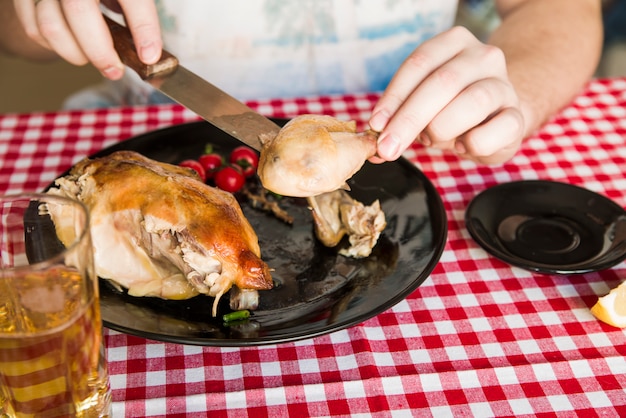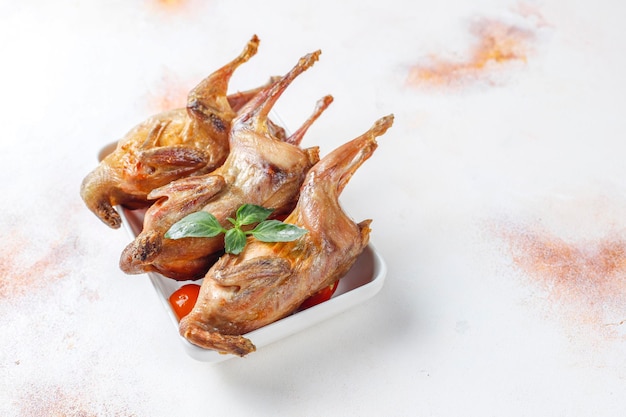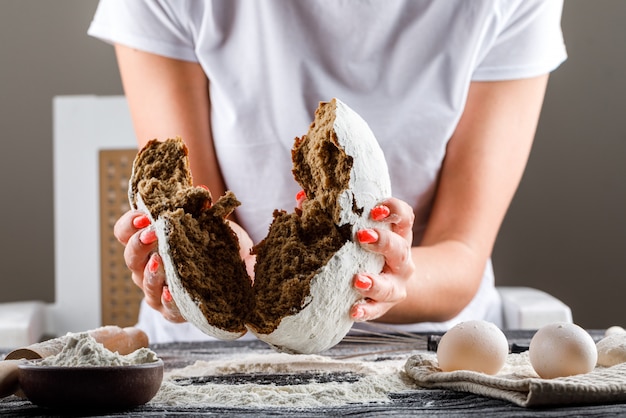(Part 1) The Butcher's Shop: Your One-Stop Shop for Lamb Perfection

I firmly believe that a good butcher is your best friend when it comes to lamb. They'll have the best selection, and they're usually happy to answer all your questions and offer advice. Honestly, I could spend hours chatting with my local butcher, learning about the different cuts and getting their tips for the best results.
The Cut: A Matter of Preference
When it comes to leg of lamb, there are two main choices: boneless and bone-in. Boneless legs are a bit easier to carve, but they tend to cook faster and can dry out a bit more easily. Bone-in legs take a bit longer to cook, but they stay juicier because the bone helps to retain moisture. The bone also adds a wonderful flavor to the meat. Ultimately, it’s a matter of preference, but I tend to gravitate towards bone-in legs. They're a bit more impressive to present on the table, and the flavour is just unbeatable.
Size: Feeding a Crowd or a Couple?
Choosing the right size leg depends on how many people you're feeding. A small leg (around 1.5kg) will be perfect for 2-4 people, while a larger leg (2.5kg or more) can feed 6-8 people. If you're unsure, don't hesitate to ask your butcher for a recommendation. They'll help you pick the perfect size to avoid leftovers or an undercooked roast.
Marbling: Key to Tenderness and Flavor
The amount of marbling (the streaks of fat) in the lamb is crucial for tenderness and flavor. Look for a leg that has a good amount of marbling, with fat evenly distributed throughout the meat. It’s this fat that renders during cooking, making the meat succulent and full of flavor. Don’t be afraid of a little fat—it’s your friend in the kitchen!
(Part 2) Seasoning and Marinating: Unlocking Flavorful Possibilities

Now that you've chosen your perfect leg of lamb, it's time to get creative with the flavor. You can go simple with a classic blend of herbs and spices, or you can create a complex marinade or rub that will transform your lamb into something truly extraordinary. The key is to season generously and evenly. Don't be shy—the lamb can handle it!
My Go-to Herb Blend: A Simple but Powerful Combo
I'm a big fan of a simple herb blend that combines rosemary, thyme, and garlic. It’s a classic pairing that really complements the taste of lamb. I always add a generous pinch of salt and peppercorns, and a sprinkle of paprika for a bit of color. You can also experiment with other herbs like dried oregano, sage, or even a bit of cayenne pepper for a kick.
Marinating: A Flavor Booster for Your Lamb
If you've got time, marinating the lamb for a few hours or even overnight is a fantastic way to amp up the flavor. It’s a bit of a magical process—the acid in the marinade tenderizes the meat while infusing it with all those delicious flavors.
Here's a simple marinade recipe that I love:
- 1/4 cup olive oil
- 2 tablespoons lemon juice
- 1 tablespoon red wine vinegar
- 1 tablespoon Dijon mustard
- 2 cloves garlic, minced
- 1 teaspoon dried rosemary
- 1 teaspoon dried thyme
- Salt and pepper to taste
Combine all the ingredients in a bowl, and whisk until well combined. Pour the marinade over the lamb, making sure to coat it evenly. Cover the lamb tightly with plastic wrap and refrigerate for at least 4 hours, or up to 24 hours. You’ll notice a huge difference in the flavor!
(Part 3) Roasting the Lamb: Time, Temperature, and Patience

The moment we’ve all been waiting for! It’s time to roast that gorgeous leg of lamb. The key to a perfectly cooked leg of lamb is a combination of time, temperature, and patience. I prefer to cook my lamb at a low temperature for a longer time. This gentle cooking method ensures that the meat stays moist and tender.
Preheating: The Foundation for a Golden Crust
Start by preheating your oven to 160°C (325°F). This ensures even heat distribution and will help to create a beautiful, golden-brown crust on your lamb.
roasting time: A Guide for Perfection
The roasting time will depend on the size of your leg of lamb. A general rule of thumb is to allow 20 minutes per 500g (1lb) for medium-rare, plus an extra 15-20 minutes for well-done. But remember, every oven is different, so it’s always best to use a meat thermometer to check for doneness.
Meat Thermometer: Your Guide to Perfect Doneness
A meat thermometer is your best friend when it comes to cooking lamb. It’s the only way to ensure that your lamb is cooked to your liking. Insert the thermometer into the thickest part of the leg, avoiding the bone. Here’s a quick guide to different levels of doneness and their corresponding temperatures:
| Doneness | internal temperature (°C) |
|---|---|
| Rare | 52-57°C |
| Medium-rare | 57-63°C |
| Medium | 63-71°C |
| Well-done | Over 71°C |
Resting: Key to Juicy Tenderness
Once your lamb is cooked, it's important to let it rest for 10-15 minutes before carving. This allows the juices to redistribute throughout the meat, resulting in a much more tender and succulent roast. It's a simple step, but it makes a big difference. I find that resting time allows the flavors to meld and create a symphony of taste.
(Part 4) Carving the Lamb: A Skill You Can Master
Now comes the fun part! It's time to carve that beautiful leg of lamb. You'll need a sharp knife, a carving fork, and a cutting board. Follow these tips to carve like a pro:
1. Slicing Against the Grain
Always slice against the grain to prevent the meat from being tough. This means slicing across the muscle fibers, not with them. Imagine you're cutting across the "stripes" in the meat. This will make the meat easier to chew and more tender.
2. Starting at the Thin End
Begin by carving at the thin end of the leg. This will help you to remove the fattier end first. Then, you can slice the remaining meat into thick, juicy slices.
3. Using a Carving Fork
Use the carving fork to hold the lamb steady as you slice it. This will make the process easier and safer. It will also prevent the lamb from sliding around on your cutting board.
(Part 5) Accompaniments for a perfect roast: Elevating the Feast
A good leg of lamb deserves amazing accompaniments, don't you think? Roasted potatoes and vegetables are classic pairings, but why not explore beyond the familiar? Let’s turn your roast into a memorable meal!
1. Roasted Vegetables: Sweet and Savory Sides
Roast root vegetables like carrots, parsnips, and potatoes for a classic and comforting pairing. Toss them with olive oil, herbs, and spices, and roast them until they are tender and slightly caramelized. You can also roast asparagus, broccoli, or even Brussels sprouts for a touch of green. They'll be beautifully browned and delicious with your lamb.
2. Saucy Sides: Adding a Layer of Flavor
A delicious sauce can really elevate your roast lamb. Think about a vibrant mint sauce, a rich red wine gravy, or a creamy mustard sauce. You can even make a simple pan sauce with the roasting juices and a little bit of wine or stock. It’s the perfect way to capture all those flavorful drippings and add a beautiful finishing touch to your meal.
3. Fresh Salads: A Refreshing Counterpoint
A fresh salad is a refreshing contrast to the richness of the lamb. Try a simple green salad with a light vinaigrette or a more substantial salad with roasted vegetables, quinoa, or chickpeas. It adds a burst of freshness and texture to your meal, making it even more satisfying.
(Part 6) FAQs: Common Questions Answered
Let's address some common questions you might have about cooking a perfect leg of lamb.
1. Can I Freeze a Leg of Lamb?
Yes, you can freeze a leg of lamb for up to 3 months. Wrap it tightly in plastic wrap and aluminum foil, and then store it in a freezer-safe bag. Make sure to label it with the date. When you’re ready to use it, thaw it in the refrigerator overnight before cooking.
2. How Do I Know If Lamb is Bad?
If the lamb has an off-odor or a slimy texture, it's best to throw it away. You can also check the “use-by” date on the packaging. If it's past the date, it's safer to err on the side of caution and discard it.
3. What are Some Other Ways to Cook Lamb?
Lamb can be cooked in many ways. You can grill it, pan-fry it, or even slow-cook it in a casserole. There are endless possibilities! If you’re looking for something different, try a lamb burger, lamb skewers, or even lamb meatballs.
4. What Wine Pairs Best with Lamb?
A full-bodied red wine, such as a Cabernet Sauvignon or a Merlot, is a classic pairing with lamb. You can also try a lighter red, such as a Pinot Noir, or even a white wine, such as a Chardonnay. The key is to choose a wine with enough complexity and depth to complement the rich flavor of the lamb.
5. How Do I Keep Lamb from Drying Out?
The key to keeping lamb moist is to cook it at a low temperature and to avoid overcooking it. A meat thermometer is your best friend, allowing you to track the temperature and ensure that the lamb is cooked to your liking without becoming dry. You can also baste the lamb with its own juices or with a pan sauce to keep it moist during cooking. It’s a simple trick that makes a big difference.
(Part 7) Enjoy the Feast!
There you have it: the ultimate guide to cooking a perfect leg of lamb! I hope this guide has given you the confidence to tackle this delicious dish. Remember, it's all about the process—choosing the right cut, seasoning it generously, and roasting it slowly until it’s tender and juicy. And most importantly, enjoy the delicious meal with your loved ones. It's a meal that will definitely leave everyone feeling satisfied and happy!
Everyone is watching

Prime Rib Roast Cooking Time Chart: Per Pound Guide
Cooking TipsPrime rib roast. Just the name conjures images of lavish dinners, crackling fires, and hearty laughter. It’s ...

How Long to Bake Potatoes in the Oven (Perfect Every Time)
Cooking TipsBaked potatoes are a staple in my kitchen. They're incredibly versatile, delicious, and surprisingly easy to m...

Perfect Rice Every Time: The Ultimate Guide to Cooking Rice
Cooking TipsAs a self-proclaimed foodie, I've always been a bit obsessed with rice. It's the foundation of countless cuisi...

The Ultimate Guide to Cooking Asparagus: Tips, Techniques, and Recipes
Cooking TipsAsparagus. The mere mention of this spring delicacy conjures up images of vibrant green spears, crisp and burs...

Ultimate Guide to Cooking the Perfect Thanksgiving Turkey
Cooking TipsThanksgiving. Just the word conjures up images of overflowing tables laden with delicious food, the scent of r...
